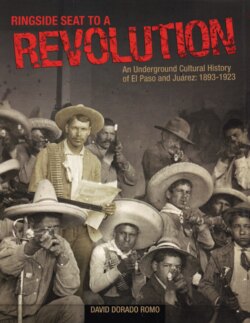Читать книгу Ringside Seat to a Revolution - David Dorado Romo - Страница 29
На сайте Литреса книга снята с продажи.
ОглавлениеChurch and because she denounced the priests for
charging money to the poor for performing their reli-
gious rites, Teresita provoked the ire of Padre Manuel
Castelo, the Tomóchic parish priest. He called
Teresita’s words and healings the work of the Devil.
Castelo threatened to excommunicate every
Tomóchic villager who believed in her. The villagers,
enraged by the threats, beat up the priest and ran him
out of town. They took control of the church build-
ing and began holding their own religious services.
When the local authorities tried to intervene, the
Tomochitecos declared
they would obey no civil
authority who violated their
religious beliefs. The
Mexican federal authorities
were called in to put the
rebellious villagers in their
place. Things got out of
hand quickly. What started
off as a local religious
squabble flared up into a
fierce battle between the
villagers and the federal
soldiers. Porfirio Díaz was
afraid that if news of the
uprising reached the world
press, foreign investment in
Mexico would suffer. The
president sent a telegram to
the governor of Chihuahua
ordering that as soon as the
Tomóchic rebels were
“apprehended, they should
be quickly and severely
punished.”22 The governor
understood this to mean the complete extermination
of the inhabitants of Tomóchic.
The greatly outnumbered villagers of Tomóchic
held the soldiers of Porfirio Díaz off for two weeks.
Their war cry was “Long live the great power of God
and the Saint of Cabora!” The Tomochitecos nearly
defeated the government troops, thanks to the rebels’
superior marksmanship, Winchester repeating rifles
and their courage inspired by the belief that Teresita
would make them impenetrable to bullets. Less than
100 fighting Tomochitecos killed more than 600 gov-
ernment soldiers. The Teresista rebels ran out of food,
water and ammunition but kept fighting even after
the federals set the village on fire. The federals cap-
tured seven rebels alive, including Cruz Chávez.
These rebels were placed against the wall and execut-
ed immediately. As punishment for the uprising, the
Díaz troops allowed the dead bodies of the fallen
Tomochitecos to rot out in the streets for days.23
Tomóchic immediately became a symbol of pop-
ular resistance against the Mexican government. It
would be a thorn in the side of the Porfirio Díaz
regime for years to come. Even 20 years later,
Maderista insurrectos took heart in the memory that
one Tomóchic rebel was
worth ten federal soldiers.
THE FIRST WEEK that
Teresita was in El Paso, she
saw about 250 patients a
day. She took male patients
in the morning and women
and children in the after-
noon. “She never charged
for her services,” the El Paso
Herald wrote. “If a rich
patron donated money to
her, she would distribute it
among the poor.”24
Newsmen reported vari-
ous healings among her
patients. One journalist saw
Teresita cure a man whose
swollen jaw “diminished
from the size of a football to
that of a baseball.”25 The El
Paso Herald wrote that
Captain Isaiah Weston visit-
ed Teresita because his left
arm had been hanging limp for days. When he came
out of her room, Weston said he was healed. George
Peck, “a well-known newspaper reporter,” claimed
Teresita healed him of the crippling effects of a para-
lytic stroke. The El Paso Herald added that on the
same day of the healings, Teresita predicted rain with-
in 12 hours, even though there were no clouds in the
sky. Four hours later, it rained.26
Unlike the evening paper, the El Paso Times was
not impressed by Teresita’s powers. The morning
daily compared her to Francis Schlatter, a half-crazed
faith healer from Denver traveling through the
Southwest that same year who claimed to be divine.
22
Telegram from Porfirio Díaz to Rafael Izabal, December 28, 1921, published in Osorio’s Tomóchic en llamas, p. 267.
23
See Francisco Almada’s La rebelión de Tomóchic en Chihuahua.
24
El Paso Herald, July 1, 1896.
25
El Paso Herald, September 23, 1896.
26
El Paso Times, June 18, 1896.
24
A José Guadalupe Posada print showing
the martyrdom of La Santa de Cabora.
(Gaceta Callejera, 1893.)
